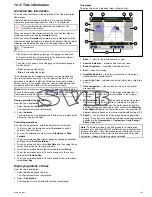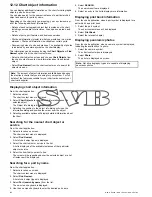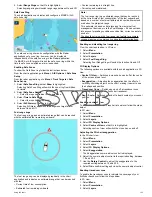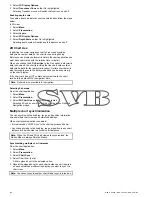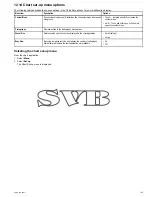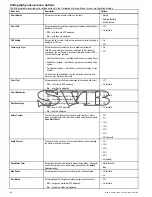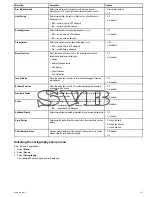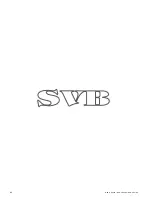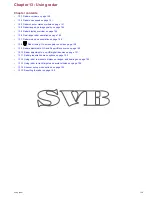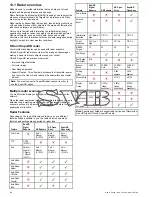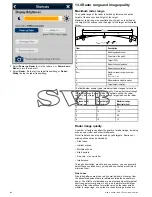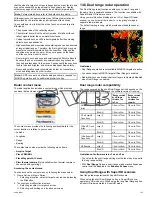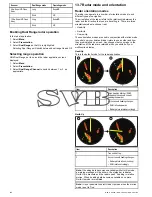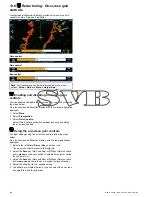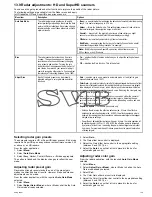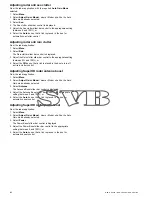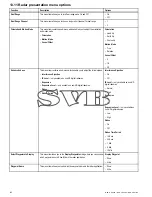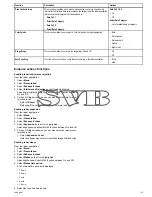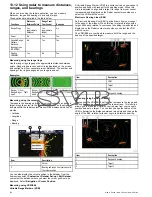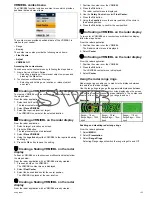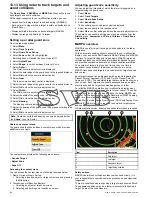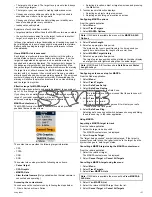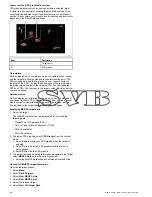
D1638-5
1
2
2
3
4
5
6
6
Item
Description
1
Main lobe
2
Side lobes
3
Antenna
4
Arc
5
True echo
6
Side echoes
Indirect Echoes
There are several types of indirect echoes or ghost images. These
sometimes have the appearance of true echoes, but in general they
are intermittent and poorly defined.
D1641-5
1
3
2
4
5
6
Item
Description
1
False echo
2
True echo
3
Passing ship
4
Mast or funnel
5
True echo
6
False echo
Multiple Echoes
Multiple echoes are not very common but can occur if there is a large
target with a wide vertical surface at a comparatively short range.
The transmitted signal will be reflected back and forth between the
target and your own ship, resulting in multiple echoes, displayed
beyond the range of the true target echo, but on the same bearing.
D1642-4
1
2
Item
Description
1
True echo
2
Multiple echoes
Blind Sectors
Obstructions such as funnels and masts near the radar antenna
may obstruct the radar beam and cause radar shadows or ‘blind
sectors’. If the obstruction is relatively narrow, there will be a
reduction of the beam intensity, though not necessarily a complete
cut-off. However, for wider obstructions there may be a total loss of
signal in the shadow area. There may also be multiple echoes which
extend behind the obstruction. Blind sector effects can normally be
minimized by careful selection of the scanner site prior to installation.
Rain or Snow Clutter
The radar can see echoes from rain or snow. Returns from storm
areas and rain squalls consist of countless small echoes that
continuously change size, intensity and position. These returns
sometimes appear as large hazy areas, depending on the intensity
of the rainfall or snow in the storm cell. The images in the table
below show how the Rain control can clear up this clutter:
Rain
clutter off
Rain
clutter on
Sea Clutter
Radar returns from waves around the vessel can clutter the centre
of the radar picture, making it difficult to detect real targets. Such
‘sea clutter’ usually appears as multiple echoes on the display at
short range scales, and the echoes are not repetitive or consistent
in position. With high winds and extreme conditions, echoes from
sea clutter may cause dense background clutter in the shape of
an almost solid disc. Sea clutter can be suppressed using the sea
clutter settings. The images in the table below show how the sea
clutter settings can clear up some of this clutter:
Using radar
143
Summary of Contents for A65
Page 2: ......
Page 4: ......
Page 8: ...8 New a Series New c Series New e Series...
Page 12: ...12 New a Series New c Series New e Series...
Page 20: ...20 New a Series New c Series New e Series...
Page 36: ...36 New a Series New c Series New e Series...
Page 64: ...64 New a Series New c Series New e Series...
Page 86: ...86 New a Series New c Series New e Series...
Page 96: ...96 New a Series New c Series New e Series...
Page 106: ...106 New a Series New c Series New e Series...
Page 138: ...138 New a Series New c Series New e Series...
Page 192: ...192 New a Series New c Series New e Series...
Page 202: ...202 New a Series New c Series New e Series...
Page 206: ...206 New a Series New c Series New e Series...
Page 218: ...218 New a Series New c Series New e Series...
Page 228: ...228 New a Series New c Series New e Series...
Page 232: ...232 New a Series New c Series New e Series...
Page 242: ...242 New a Series New c Series New e Series...
Page 248: ...248 New a Series New c Series New e Series...
Page 286: ...286 New a Series New c Series New e Series...
Page 300: ...300 New a Series New c Series New e Series...
Page 307: ......
Page 308: ...www raymarine com...

